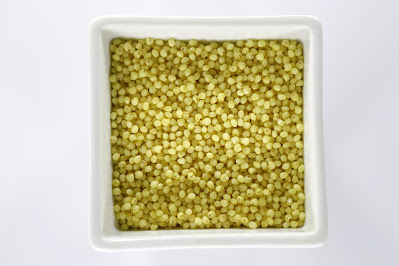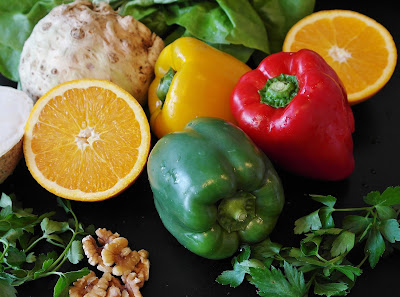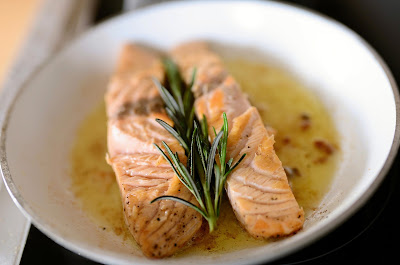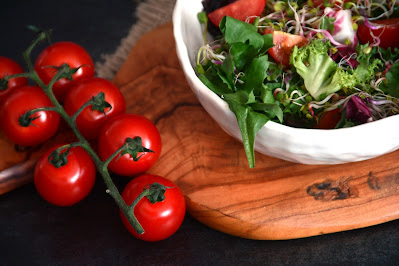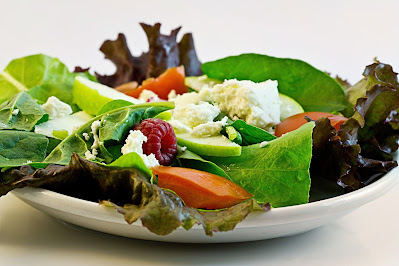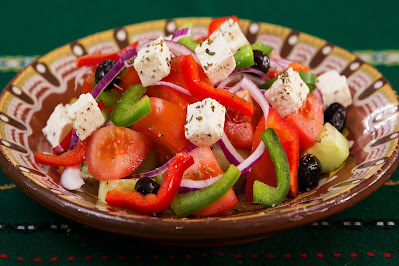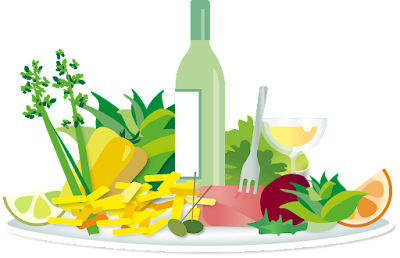Controlling food portions is crucial for weight loss as it helps you manage your calorie intake. Here are some tips to help you control food portions effectively:
Use smaller plates and bowls: Research suggests that people tend to eat more when they use larger plates and bowls. By using smaller dinnerware, you can trick your brain into perceiving larger portions, which can help you feel satisfied with less food.
Measure and weigh your food: Invest in a food scale and measuring cups to accurately measure your food portions. This method ensures you're aware of the exact amount you're consuming. Over time, you'll become better at estimating portion sizes without needing to measure everything.
Follow appropriate serving sizes: Familiarize yourself with appropriate serving sizes for different food groups. Pay attention to recommended serving sizes on nutrition labels. For example, a serving of lean protein like chicken or fish is typically around 3 to 4 ounces, while a serving of grains may be around 1/2 to 1 cup.
Fill half your plate with vegetables: Vegetables are low in calories and high in fiber, which helps you feel full. Make it a habit to fill at least half of your plate with non-starchy vegetables like broccoli, spinach, peppers, or cauliflower. This automatically reduces the space available for higher-calorie foods.
Be mindful of high-calorie foods: While it's important to include a variety of foods in your diet, be aware of calorie-dense foods. These include items like oils, nuts, seeds, cheese, and sweets. Use smaller portions of these high-calorie foods or opt for lower-calorie alternatives.
Pre-portion your meals and snacks: Prepare your meals and snacks in advance and portion them into individual containers. This eliminates the need to estimate serving sizes in the moment and helps prevent overeating. Pre-portioning also makes it easier to grab a healthy snack on the go, avoiding impulse eating.
Slow down and savor your food: Eating slowly and mindfully can enhance your satisfaction and help you recognize when you're full. Chew your food thoroughly, savor the flavors, and pay attention to your body's signals of hunger and fullness. Put your utensils down between bites to give yourself time to register satiety.
Use visual cues for portion control: If you don't have measuring tools available, you can use visual cues to estimate portion sizes. For example, a serving of protein (e.g., meat, fish, tofu) is roughly the size of a deck of cards or the palm of your hand. A serving of grains (e.g., rice, pasta) is about the size of a tennis ball or your clenched fist.
Practice portion control at restaurants: Restaurant portions tend to be larger than what we need. To control portion sizes when dining out, consider sharing a meal with a dining companion, ordering an appetizer as your main course, or asking for a to-go box at the beginning of the meal and putting half of your meal in it to save for later.
Listen to your body's hunger and fullness cues: Pay attention to your body's signals of hunger and fullness. Eat when you're genuinely hungry and stop eating when you feel comfortably satisfied, but not overly full. Avoid mindless snacking or eating out of boredom or emotions.
Remember, portion control is just one aspect of a healthy lifestyle. It's important to focus on balanced nutrition, regular physical activity, and overall well-being to support sustainable weight loss and overall health.
Exercises, Diet, Workout and Tips on How to Reduce My Waist, How to Lose Weight, How to Lose Belly Fat, Weight Loss Tips, Belly Fat Diet, Exercises to Lose Belly Fat, Healthy Weight Loss, Reduce Tummy, Waist and Stomach and Waist Slimming Exercises.
Monday, 15 May 2023
How to Control Food Portions for Successful Weight Loss
Monday, 1 May 2023
Health And Weight Loss Benefits Of Proso Millet
Proso millet, also known as broomcorn millet, is a type of cereal grain that has been grown for thousands of years in many parts of the world, including Asia, Europe, and North America. It is a nutritious food that offers several health, weight loss, and fat loss benefits, including:
High in fiber: Proso millet is high in fiber, which can help improve digestion and promote satiety. Consuming high-fiber foods can also help regulate blood sugar levels, reduce cholesterol levels, and lower the risk of heart disease.
Low glycemic index: Proso millet has a low glycemic index, which means that it does not cause a rapid spike in blood sugar levels. This can help regulate blood sugar levels, reduce cravings for sugary or high-carbohydrate foods, and promote weight loss.
Low in fat: Proso millet is low in fat, making it an ideal food for weight loss and fat loss. Consuming low-fat foods can help create a calorie deficit, which is necessary for weight loss.
High in protein: Proso millet is a good source of protein, which is essential for building and repairing tissues in the body. Eating high-protein foods can also help promote satiety, reduce hunger, and preserve muscle mass during weight loss.
Gluten-free: Proso millet is gluten-free, making it an excellent food choice for people with celiac disease or gluten intolerance.
Rich in vitamins and minerals: Proso millet is a good source of several vitamins and minerals, including iron, magnesium, phosphorus, and vitamin B6. These nutrients are essential for maintaining good health and can help boost energy levels and reduce the risk of chronic diseases.
Versatile: Proso millet is a versatile food that can be used in a variety of recipes, including porridges, salads, soups, and stews. This makes it easy to incorporate into a healthy diet.
In summary, proso millet is a nutritious and versatile food that offers several health, weight loss, and fat loss benefits. It is high in fiber, low in fat, and has a low glycemic index, making it an excellent food choice for people looking to lose weight or maintain a healthy diet. It is also a good source of protein, vitamins, and minerals, making it an ideal food for overall health and wellbeing.
Sunday, 23 April 2023
Health And Weight Loss Benefits Of Turmeric
Turmeric is a spice that is commonly used in Indian, Middle Eastern, and Southeast Asian cuisines. It has a deep yellow-orange color and a warm, bitter taste. Turmeric contains a compound called curcumin, which is responsible for its many potential health benefits. Here are some of the potential health benefits of turmeric:
Anti-inflammatory properties: Curcumin is a potent anti-inflammatory compound, which can help reduce inflammation throughout the body.
Antioxidant properties: Turmeric is rich in antioxidants, which can help protect the body against damage from free radicals.
Pain relief: Turmeric has been shown to help relieve pain, particularly in those with osteoarthritis and rheumatoid arthritis.
Improved brain function: Some studies have found that curcumin may improve cognitive function and reduce the risk of Alzheimer's disease.
Lowered risk of heart disease: Curcumin may help lower LDL (bad) cholesterol levels and reduce the risk of heart disease.
Potential weight loss benefits: Some studies have found that turmeric may help promote weight loss by reducing inflammation, improving insulin sensitivity, and increasing metabolism.
Turmeric is a versatile spice that can provide a range of potential health benefits. However, it's important to note that more research is needed to fully understand the extent of these benefits and how they may vary depending on individual health status and other factors. If you are considering using turmeric as a supplement, it's important to talk to your doctor first, especially if you are taking medications or have underlying health conditions.
Friday, 14 April 2023
Can Green Tea Help Reduce My Waist
Green tea is a popular beverage that has been shown to have a number of potential health benefits, including aiding in weight loss.
One of the ways that green tea may contribute to weight loss is by increasing metabolism. Green tea contains caffeine and catechins, two compounds that have been shown to increase metabolic rate and fat oxidation, which is the process by which the body breaks down fat for energy. This increased metabolic rate can lead to an increased calorie burn, which can help to support weight loss.
Green tea may also help to reduce appetite and cravings, which can be important for weight management. Some studies suggest that the catechins in green tea may help to reduce levels of the hunger hormone ghrelin, which can lead to decreased appetite and reduced calorie intake.
Furthermore, green tea has been shown to have anti-inflammatory and antioxidant properties, which can help to reduce inflammation in the body and protect against oxidative stress. Inflammation and oxidative stress are associated with a number of health problems, including obesity and metabolic disorders, so reducing these factors may be beneficial for overall health and weight management.
It's important to note that while green tea may be helpful for weight loss, it's not a magic solution on its own. A healthy and balanced diet, regular exercise, and a sustainable lifestyle are still important for achieving and maintaining a healthy weight.
Green tea can be a healthy and refreshing addition to a weight loss plan. However, it's important to talk to a healthcare provider before adding green tea or any other supplement to your diet, especially if you have any underlying health conditions or are taking medications.
Friday, 7 April 2023
Is Strength Training Good for Weight Loss
Yes, strength training can be very effective for weight loss. While cardio exercises like running or cycling burn calories during the activity, strength training builds muscle mass, which can increase the number of calories you burn throughout the day, even while you're at rest.
Muscle is more metabolically active than fat, meaning it requires more energy (calories) to maintain. So as you build more muscle through strength training, your body burns more calories throughout the day to maintain that muscle mass. This can increase your overall metabolic rate, which can lead to weight loss.
Additionally, strength training can help improve your body composition by reducing body fat and increasing lean muscle mass. This can lead to a more toned and sculpted appearance, even if the number on the scale doesn't change significantly.
It's important to note that strength training alone may not be enough to achieve significant weight loss. A combination of regular strength training, cardiovascular exercise, and a healthy diet is generally the most effective approach to weight loss. But incorporating strength training into your routine can certainly be a valuable tool for achieving your weight loss goals.
Tuesday, 28 March 2023
Reduce Your Waist With The Green Mediterranean Diet
The Mediterranean diet has long been touted as one of the healthiest diets in the world, with its emphasis on fresh fruits and vegetables, whole grains, lean proteins, and healthy fats. However, recent studies have shown that adding even more plant-based foods to the Mediterranean diet can have even greater health benefits. This is where the Green Med diet comes in.
The Green Med diet is a plant-based version of the Mediterranean diet that emphasizes leafy greens, cruciferous vegetables, herbs, and spices. Studies have shown that a diet rich in these foods can reduce inflammation, lower blood pressure, and even prevent chronic diseases like heart disease and diabetes.
So, what does a typical day on the Green Med diet look like? Here are some meal examples:
Breakfast:
Avocado toast with whole grain bread, topped with sliced cherry tomatoes and a sprinkle of herbs
Green smoothie made with spinach, kale, banana, almond milk, and a scoop of plant-based protein powder
Lunch:
Greek salad with mixed greens, cucumber, tomato, red onion, olives, feta cheese, and a homemade vinaigrette
Lentil soup with lots of leafy greens and a side of whole grain bread
Snack:
Hummus with carrot sticks and sliced bell peppers
Apple slices with almond butter and a sprinkle of cinnamon
Dinner:
Grilled eggplant and zucchini with a side of whole grain couscous, topped with a lemon-herb sauce
Chickpea and vegetable stir-fry with lots of leafy greens and served over brown rice
Dessert:
Fresh fruit salad with a drizzle of honey and a sprinkle of cinnamon
Homemade chia seed pudding with almond milk and topped with fresh berries
The Green Med diet is not only delicious but also incredibly nutritious. By emphasizing plant-based foods, you are not only getting a variety of vitamins and minerals but also a good dose of fiber, which can keep you feeling full and satisfied throughout the day. So, next time you're looking to switch up your diet, give the Green Med diet a try!
Monday, 20 March 2023
Reduce Your Waist With The Body Reset Diet Plan
The Body Reset Diet Plan With Meal Examples
The Body Reset Diet is a 15-day diet plan developed by celebrity fitness trainer Harley Pasternak. The plan focuses on a variety of plant-based foods, high protein meals, and smoothies. Here are five meal examples from the Body Reset Diet:
Breakfast: Chocolate banana smoothie made with 1 cup unsweetened almond milk, 1 banana, 1 scoop of chocolate protein powder, and 1 tablespoon of almond butter. Total calorie count: approximately 350 calories.
Snack: Sliced cucumber with 2 tablespoons of hummus. Total calorie count: approximately 100 calories.
Lunch: Grilled chicken breast with mixed greens, cherry tomatoes, and 1 tablespoon of balsamic vinaigrette dressing. Total calorie count: approximately 250 calories.
Snack: A small apple with 1 tablespoon of almond butter. Total calorie count: approximately 150 calories.
Dinner: Grilled salmon with roasted asparagus and brown rice. Total calorie count: approximately 400 calories.
It is important to note that the Body Reset Diet plan encourages consuming three smoothies a day and two healthy snacks along with one solid meal. The above meal examples can be modified according to personal preferences and dietary restrictions. It is recommended to consult a healthcare professional before starting any new diet or exercise program.
If you found this article interesting, you may want to read this..... Click here to access...
Monday, 13 March 2023
Reduce My Waist With The TLC Diet
The Therapeutic Lifestyle Changes (TLC) diet is a heart-healthy eating plan developed by the National Cholesterol Education Program (NCEP). It is designed to lower cholesterol levels and reduce the risk of heart disease by emphasizing nutrient-dense, low-fat foods while limiting or avoiding saturated and trans fats. In this article, we will discuss the principles of the TLC diet and provide five meal examples that are consistent with this eating plan.
Principles of the TLC Diet
The TLC diet emphasizes reducing saturated and trans fats, which are found in animal-based products, fried foods, and baked goods. It also emphasizes increasing intake of nutrient-dense foods such as fruits, vegetables, whole grains, and lean proteins. The diet is divided into three categories, with varying levels of fat intake:
Step 1: Limit saturated and trans fats to less than 7% of daily calories and limit dietary cholesterol to less than 200 mg per day.
Step 2: Further reduce saturated fat intake to less than 5-6% of daily calories.
Step 3: Maintain a heart-healthy eating plan with an emphasis on nutrient-dense, low-fat foods.
The TLC diet also emphasizes regular physical activity and weight management as key components of a heart-healthy lifestyle.
Meal Examples
Here are five meal examples that are consistent with the TLC Diet:
Breakfast: Whole-grain cereal with low-fat milk and berries
Serve 1 cup of whole-grain cereal (such as oats or bran flakes) with 1 cup of low-fat milk.
Top with 1/2 cup of fresh berries (such as blueberries or strawberries) for added flavor and nutrition.
Lunch: Grilled chicken and vegetable wrap
Grill 4 ounces of boneless, skinless chicken breast and slice into thin strips.
Layer the chicken with 1 cup of mixed vegetables (such as lettuce, tomatoes, and cucumbers) on a whole-grain wrap.
Drizzle with a homemade vinaigrette made with 1 tablespoon of olive oil and 1 tablespoon of vinegar.
Snack: Raw vegetables with hummus
Serve 1 cup of raw vegetables (such as carrots, celery, and bell peppers) with 2 tablespoons of hummus.
Optional: sprinkle with sea salt or black pepper for extra flavor.
Dinner: Baked salmon with roasted vegetables
Bake 4 ounces of salmon with 1 tablespoon of olive oil and lemon juice at 400°F for 15-20 minutes.
Serve with a side of roasted vegetables (such as broccoli, Brussels sprouts, and cauliflower) drizzled with 1 tablespoon of olive oil.
Dessert: Fresh fruit salad
Combine 1 cup of mixed fruits (such as apples, oranges, and grapes) in a bowl.
Optional: top with a dollop of whipped cream or yogurt for added sweetness.
The TLC diet is a heart-healthy eating plan that emphasizes nutrient-dense, low-fat foods while limiting or avoiding saturated and trans fats. By incorporating the meal examples provided above, you can easily follow the principles of the TLC diet and enjoy a variety of delicious and nutritious meals. However, as with any diet plan, it is important to consult with a healthcare professional to determine if this eating plan is suitable for you and your specific health needs.
Like to know my personal favorite Weight Loss Regime....Click Here to know more...
Monday, 6 March 2023
Top 10 Weight Loss Diets That Actually Work
In recent years, weight loss diets have become increasingly popular as people strive to achieve their desired body weight and improve their overall health. With so many different diets to choose from, it can be overwhelming to decide which one to follow. Each diet has its own unique approach to weight loss, with varying restrictions and recommendations for food and drink consumption. In this article, we will explore 10 different types of weight loss diets, their underlying principles, and the potential benefits they offer. Whether you are looking to reduce your calorie intake, eliminate certain foods, or change the way you eat entirely, there is sure to be a diet that aligns with your goals and preferences.
Top 10 Fat Loss Diets That Actually Work
Ketogenic Diet: A low-carbohydrate, high-fat diet that forces the body to burn fat for energy instead of carbohydrates. The goal is to achieve a state of ketosis where the body produces ketones as an alternative source of fuel.
Mediterranean Diet: A diet inspired by the traditional eating habits of countries bordering the Mediterranean Sea. It emphasizes plant-based foods, healthy fats, and whole grains while limiting processed foods, red meat, and sugar.
Paleo Diet: A diet that focuses on foods that would have been available to our Paleolithic ancestors, including lean meats, fish, fruits, vegetables, nuts, and seeds. It eliminates grains, legumes, dairy, and processed foods.
Vegetarian Diet: A diet that excludes meat, poultry, and fish. It typically includes a variety of plant-based foods such as fruits, vegetables, whole grains, legumes, and nuts.
Vegan Diet: A diet that excludes all animal products, including meat, dairy, eggs, and honey. It relies heavily on plant-based foods such as fruits, vegetables, whole grains, legumes, and nuts.
DASH Diet: The Dietary Approaches to Stop Hypertension (DASH) diet is designed to lower blood pressure. It emphasizes fruits, vegetables, whole grains, and low-fat dairy while limiting saturated fats, red meat, and sugar.
Whole30 Diet: A 30-day elimination diet that eliminates all processed foods, added sugars, grains, legumes, and dairy. The goal is to reset the body and identify food sensitivities.
Low-Fat Diet: A diet that limits fat intake to reduce calories. It typically emphasizes lean proteins, whole grains, fruits, and vegetables while limiting high-fat foods such as butter, oil, and cheese.
Zone Diet: A diet that balances protein, carbohydrates, and fat in each meal to regulate insulin levels and promote weight loss. It typically involves eating meals that are 40% carbohydrates, 30% protein, and 30% fat.
Intermittent Fasting: A diet that involves alternating periods of fasting and eating. There are several variations, including 16/8 (fasting for 16 hours and eating during an 8-hour window) and 5:2 (eating normally for 5 days and restricting calories to 500-600 for 2 days).
Monday, 27 February 2023
120 Common Foods Of A Mediterranean Diet
A Mediterranean Diet:120 Common Foods
Olive oil
Tomatoes
Feta cheese
Kalamata olives
Greek yogurt
Eggplant
Red peppers
Hummus
Chickpeas
Garlic
Onion
Basil
Oregano
Rosemary
Thyme
Lemon
Oranges
Grapefruit
Fennel
Artichokes
Spinach
Arugula
Radicchio
Zucchini
Squash
Broccoli
Cauliflower
Carrots
Sweet potatoes
Potatoes
Red onion
Green onion
Cucumber
Celery
Mushrooms
Green beans
Asparagus
Lentils
Quinoa
Brown rice
Whole grain bread
Whole grain pasta
Barley
Bulgur
Couscous
Pita bread
Almonds
Walnuts
Pistachios
Hazelnuts
Pine nuts
Cashews
Sesame seeds
Sunflower seeds
Pumpkin seeds
Sardines
Anchovies
Salmon
Tuna
Mackerel
Swordfish
Shrimp
Clams
Scallops
Octopus
Calamari
Chicken
Turkey
Lamb
Beef
Veal
Pork
Duck
Eggs
Milk
Cheese
Yogurt
Cottage cheese
Soy milk
Tofu
Avocado
Watermelon
Cantaloupe
Honeydew
Strawberries
Blueberries
Blackberries
Raspberries
Grapes
Apples
Pears
Peaches
Plums
Cherries
Oranges
Grapefruit
Lemons
Pomegranate
Dates
Figs
Prunes
Raisins
Honey
Maple syrup
Balsamic vinegar
Red wine vinegar
Apple cider vinegar
White wine vinegar
Dijon mustard
Hot sauce
Salsa
Tomato sauce
Pesto
Tahini
Harissa
Za'atar
Sumac
Cumin
Paprika
Turmeric
Keep in mind that this list is not exhaustive, and there are many other foods that can be incorporated into a Mediterranean diet. The key is to focus on whole, minimally processed foods that are rich in nutrients and flavor.
A 3-Meal 7-Day Mediterranean Diet Plan
A 3-Meal 7-Day Mediterranean Diet Regime
Here is an example of a 3-meal, 7-day Mediterranean diet plan:
Day 1:
Breakfast: Greek yogurt with fresh berries and honey, whole grain toast with avocado and tomato slices.
Lunch: Grilled chicken breast with mixed greens, cucumber, and tomato salad dressed with olive oil and lemon juice.
Dinner: Baked salmon with roasted vegetables (such as zucchini, bell peppers, and onions) drizzled with olive oil and sprinkled with herbs.
Day 2:
Breakfast: Omelette with spinach, tomato, and feta cheese, whole grain toast.
Lunch: Greek salad with mixed greens, cherry tomatoes, cucumber, olives, and feta cheese dressed with olive oil and red wine vinegar.
Dinner: Grilled lamb chops with roasted potatoes and green beans, seasoned with garlic and rosemary.
Day 3:
Breakfast: Whole grain cereal with almond milk, sliced banana, and chopped nuts.
Lunch: Tuna and white bean salad with mixed greens, tomatoes, and red onion dressed with olive oil and lemon juice.
Dinner: Whole wheat spaghetti with tomato sauce, sautéed garlic shrimp, and a side salad.
Day 4:
Breakfast: Scrambled eggs with sautéed spinach and mushrooms, whole grain toast.
Lunch: Chickpea and vegetable stew with crusty whole grain bread.
Dinner: Grilled chicken skewers with mixed vegetables (such as bell peppers, onions, and mushrooms), served with whole grain couscous.
Day 5:
Breakfast: Greek yogurt with fresh berries and honey, whole grain toast with almond butter.
Lunch: Grilled vegetable sandwich with hummus and whole grain bread, side salad.
Dinner: Baked white fish (such as cod or tilapia) with roasted asparagus and cherry tomatoes, drizzled with olive oil and lemon juice.
Day 6:
Breakfast: Smoothie with Greek yogurt, frozen berries, banana, and almond milk.
Lunch: Whole wheat pita stuffed with falafel, hummus, and vegetables (such as tomato, cucumber, and lettuce).
Dinner: Grilled steak with roasted sweet potatoes and a side salad.
Day 7:
Breakfast: Whole grain pancakes with fresh fruit and maple syrup.
Lunch: Greek salad with mixed greens, cherry tomatoes, cucumber, olives, and feta cheese dressed with olive oil and red wine vinegar.
Dinner: Ratatouille (a stew of eggplant, zucchini, bell peppers, onions, and tomatoes) with a side of crusty whole grain bread.
Remember, this is just one example of a Mediterranean diet plan, and there are many different variations and options to choose from. Be sure to incorporate a variety of fruits, vegetables, whole grains, legumes, and healthy fats into your meals, and enjoy the delicious flavors of this healthy and sustainable way of eating.
Advantages Of A Mediterranean Diet In Weight Loss
The Mediterranean diet is a way of eating that is based on the traditional dietary patterns of countries bordering the Mediterranean Sea, such as Greece, Italy, and Spain. It is characterized by a high consumption of fruits, vegetables, whole grains, legumes, nuts, and olive oil, moderate intake of fish and dairy products, and low consumption of red meat and processed foods.
The Mediterranean diet has been extensively researched and has been found to have numerous health benefits, including weight loss. Here are some advantages of the Mediterranean diet in weight loss:
High in fiber: The Mediterranean diet is rich in fiber from fruits, vegetables, whole grains, and legumes. High-fiber foods keep you feeling full for longer, reducing your appetite and helping you eat less.
Low in processed foods: The Mediterranean diet emphasizes whole, minimally processed foods over highly processed ones. Processed foods are often high in calories, sugar, and unhealthy fats, and can lead to weight gain over time.
Rich in healthy fats: The Mediterranean diet is high in monounsaturated and polyunsaturated fats, found in olive oil, nuts, and fatty fish like salmon. These healthy fats can help you feel full, reduce inflammation, and improve cholesterol levels.
Promotes balanced meals: The Mediterranean diet emphasizes a balance of macronutrients, with moderate amounts of protein and healthy fats and a focus on complex carbohydrates like whole grains and vegetables. This balanced approach can help you maintain a healthy weight over the long term.
Emphasizes mindful eating: The Mediterranean diet is not just about what you eat, but how you eat. The diet emphasizes mindful eating, savoring each bite, and paying attention to hunger and fullness cues. This approach can help you avoid overeating and make healthier food choices.
May reduce inflammation: The Mediterranean diet is rich in anti-inflammatory foods like fruits, vegetables, and fatty fish. Chronic inflammation has been linked to obesity and other health problems, so reducing inflammation may help with weight loss.
May improve gut health: The Mediterranean diet is high in fiber and fermented foods like yogurt and kefir, which can improve gut health. A healthy gut microbiome has been linked to a healthy weight.
Sustainable and enjoyable: One of the key advantages of the Mediterranean diet is that it is a sustainable way of eating that can be enjoyed for a lifetime. Unlike fad diets that may lead to short-term weight loss followed by weight gain, the Mediterranean diet is a healthy and balanced approach to eating that can be sustained over the long term.
The Mediterranean diet is a healthy and sustainable way of eating that can lead to weight loss. Its emphasis on whole, minimally processed foods, healthy fats, and mindful eating can help you feel full, reduce inflammation, and make healthier food choices. Incorporating the Mediterranean diet into your lifestyle may not only help you lose weight but also improve your overall health and well-being.

